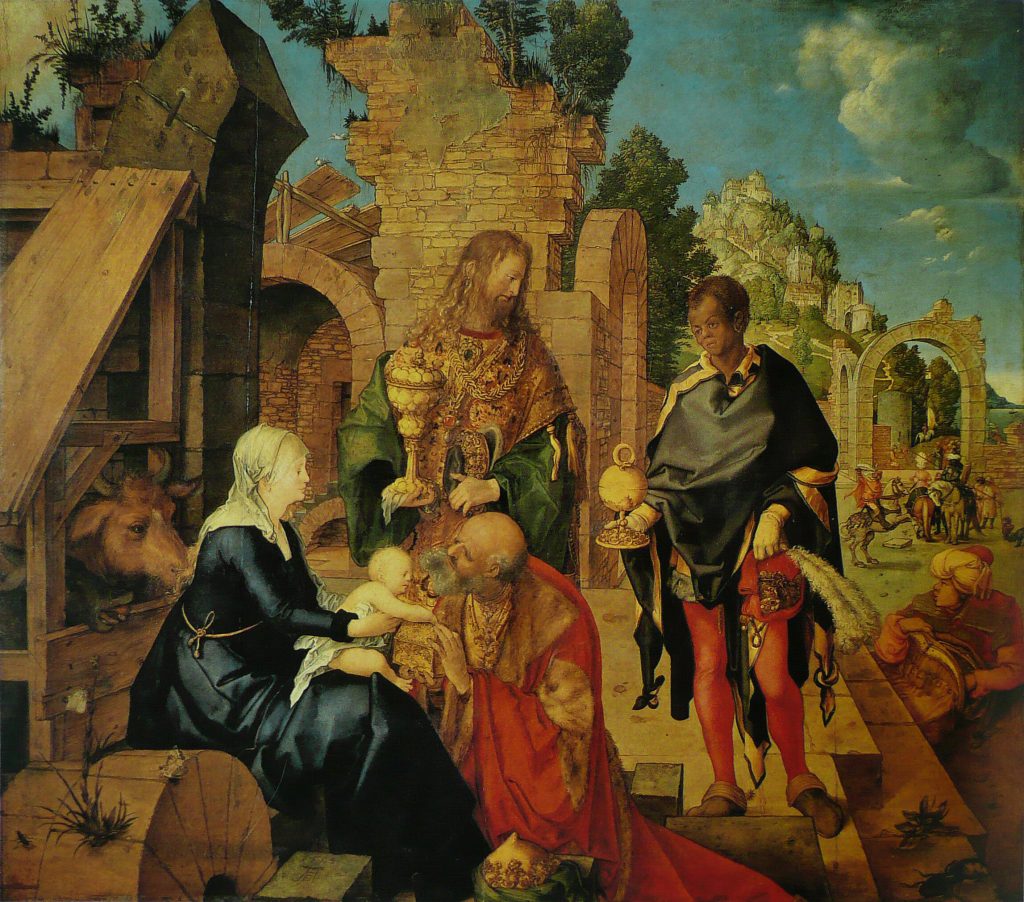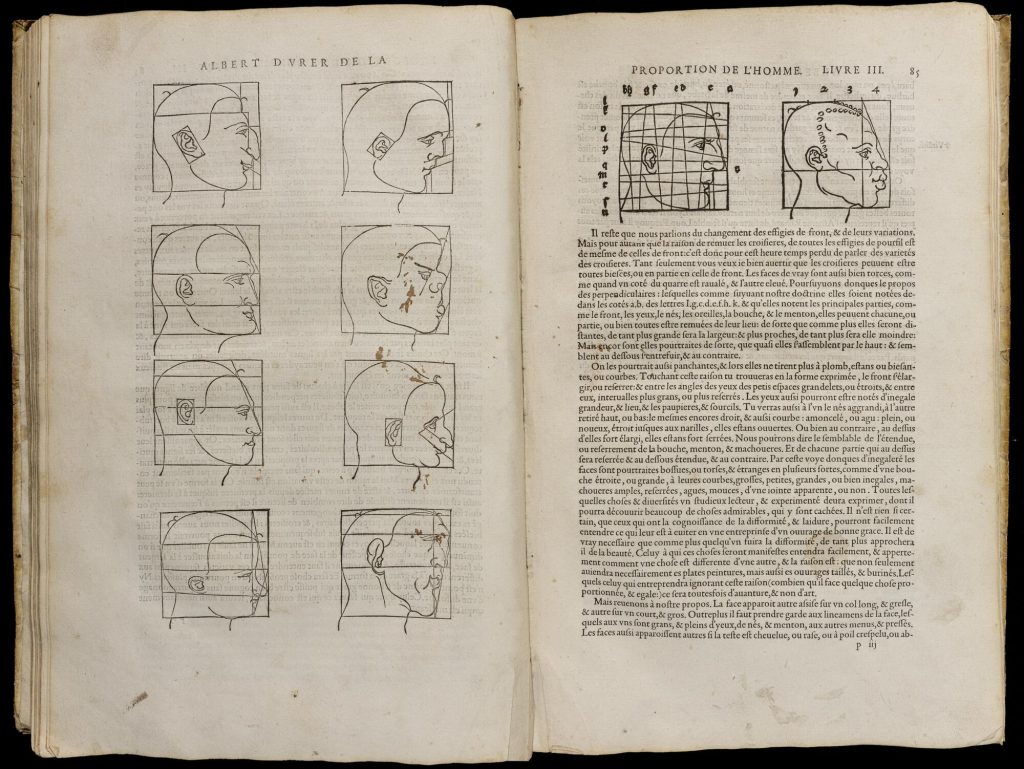Themes
Albrecht Dürer
Art History
Europe
Race
Periods & Events
Early Modern Period
Renaissance
Skills & Document Types
Image Analysis
Materials – Available for Download in the Downloads Tab
- A copy of the “Albrecht Dürer and Representations of Race in the Renaissance” lesson
- Image from the 1528 German edition of Dürer’s Four Books on Human Proportion (high-resolution version)
- Image from the 1557 French edition of Dürer’s Four Books on Human Proportion (high-resolution version)
- Excerpt from the 1557 French edition
Process
This lesson is for a teacher-controlled class. However, students can also perform this lesson independently or in small groups. For this option, download the copies of the source images in the Downloads tab or give them a link to the Newberry collections with the handout PDF.
The lesson structure is intended for one 50-minute session, but additional material could be added for an extended lesson and more advanced class.
This lesson is broken down into three steps or skills: study of one image, comparative analysis between two images, and textual and visual comparative analysis. An extension activity explores a related painting.
Step 1: Single Image Study
The First German Edition of Dürer’s Four Books on Human Proportion

In the early sixteenth century the renowned German artist Albrecht Dürer wrote a book, entitled The Four Books on Human Proportion, as a guide for artists who were representing diverse people in art. Dürer’s book provided instructions for how to measure different parts of the body. First published in German in 1528, the book became very popular and was published in five languages and issued in more than 15 different editions throughout the century.
Begin by showing the students this image from the first German edition of Dürer’s book on proportion (1528). Then have the students discuss the following questions:
- What do you see on this page? Who is represented? Why do you think they are depicted in this way?
- How are these heads represented on the page? How are the heads measured?
- What does this page of images remind you of today?
Students can also look through the entire book on Internet Archive.
Takeaways
Profile portraits with lines delineated the angles of facial features create these striking representations of diverse heads of men. The use of profiles allows for the study of the distinct features of the figures and makes it easy to measure and compare noses in particular. Students might recognize that the profile is used in mug shots and that this form of representation was later used in racial profiling beginning in the twentieth century and continuing today to catalogue different facial types.
Step 2: Compare Two Images
Later French Edition of Dürer’s Four Books on Human Proportion
Ask students to compare and contrast the page from the German (1528) edition and the pages from the French (1557) edition of Dürer’s book.
Then have the students discuss the following questions:
- How is the French edition different from the German edition?
- How does the different page layout of the two editions change the message? (A change in page layout can alter the meaning of the images. Adding those two heads on the next page and putting them in contrast with the other page emphasizes the differences between the heads.)
- Why do you think the producers of the French edition made these changes?
- Why should we look at two editions of the same book? What can this study tell us?
Students can also engage with this interactive site that explores the French edition.
Takeaways
Page layout can transform one’s experience with a book. Examining different editions can help us understand how books were used and studied over time. Editions of books can also highlight the priorities or beliefs of whatever time period the book was reproduced in. These two editions make clear that these images remained important for artistic practice and for conceiving of the best way to represent diverse men. Also, note that there are stains on the pages of the French book that indicate that it was used by artists in the workshop. Looking closely at details and marks in books can also be revelatory about their meaning and use.
Step 3: Compare Images and Text
Ask students to read two sentences from the French translation of Dürer’s book and to think about them in relation to the images on the page nearby.
Il n’est rien si certain, que ceux qui ont la cognoissance de la difformité, & laidure, pourront facilement entendre ce qui leur est à euiter en une entreprinse d’un ouurage de bonne grace. Il est de vray necessaire que comme plu quelqu’un fuira la diffromité, de tant plus approchera il de la beauté.
Most certainly, those who know deformity and ugliness will easily understand what to avoid as they develop a graceful work. For, unavoidably, the more someone flees from deformity, the more they approach beauty.
Then have the students discuss the following questions:
- How does this passage relate to the images nearby?
- According to this passage, what is the role of the artist?
- How do you think Dürer is defining “deformity” and “beauty” in this context?
Takeaways
The passage provides some of Dürer’s ideas behind the making of these images by the artist. It indicates that the belief was that some faces are deformed and some are beautiful and that by studying the different types, the artist can himself understand or perhaps attain beauty. The passage obliquely comments on beauty standards of the sixteenth century and in doing so could be reinforcing ideas about race, inferring that certain people are more beautiful or better than others. Though Dürer does not express this explicitly in the text, these images (like other texts and images from this period in books) visually classify features (noses, mouths, foreheads) in a way that distinguishes race.
Optional Extension Activity

This is a small-scale painting that Dürer painted for a church in Wittenberg Germany for an elite private patron. It represents the “Adoration of the Magi” which is the moment in which Mary, Joseph, and baby Jesus rest on their travels and are greeted by three kings who bring gifts from different parts of the world. The “Adoration” was a popular moment to represent in art throughout the Middle Ages and Renaissance and we continue to see the scene depicted in churches and in homes at Christmas time throughout the world.
Ask the students to study the painting in relation to the page of Dürer’s book just examined and consider the following questions.
- How might Dürer’s book have helped artists to represent the faces of the three kings in paintings?
- How does Dürer represent the three kings? Why does he represent them in this way?
- How does color aid in the depiction of difference?
- What other details do you see in the painting that might tell us more about the representation of race in the Renaissance?
About the Author
Lia Markey (Ph.D., University of Chicago) is the Director of the Center for Renaissance Studies. Her publications include a book, Imagining the Americas in Medici Florence (2016), and two edited volumes, The New World in Early Modern Italy, 1492-1750 (2017) with Liz Horodowich, and Renaissance Invention: Stradanus’s “Nova Reperta” (2020). She teaches at the University of Chicago and Northwestern University and has held fellowships at the Folger Library, the Warburg Institute, the Villa I Tatti, the Metropolitan Museum of Art, the Herzog August Bibliothek, and European University Institute. She co-curated the Newberry exhibition Seeing Race before Race (fall 2023) and co-edited with Noémie Ndiaye the related publication by the same name.
Download the following materials below:
- Copy of the lesson “Albrecht Dürer and Representations of Race in the Renaissance”
- Images and excerpts from the 1528 German edition of Dürer’s Four Books on Human Proportion (high-resolution version) and the 1557 French edition of Dürer’s Four Books on Human Proportion (high-resolution version)
Related Lessons
A third lesson based on Seeing Race before Race coming soon!
Additional Resources on this Topic
- Section on Dürer in Seeing Race Before Race: A Closer Look, an interactive storymap based on the Newberry exhibition Seeing Race Before Race.
- Olivia Dill, “Entry #5 on Dürer” in Seeing Race Before Race: Visual Culture and the Racial Matrixin the Premodern World, eds. Noémie Ndiaye and Lia Markey
- Noam Andrews, “Racial Profiling: Delineating the Renaissance Face” in Teaching Race in the European Renaissance: A Classroom Guide, ed. Matthieu Chapman and Anna Wainwright






